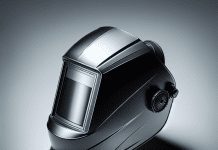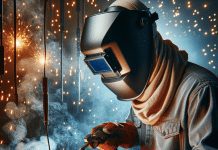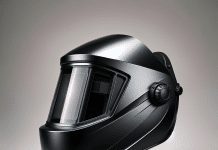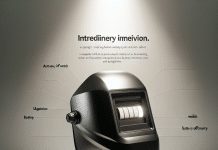Imagine working on a project that requires you to weld overhead, with sparks constantly falling around you. It can be a dangerous and uncomfortable task if you don’t have the right protection. That’s where the Best Welding Helmets for Overhead Welding come in. Designed specifically to prevent falling sparks from reaching your face and eyes, these helmets offer unparalleled safety and peace of mind. In this article, we will explore the top welding helmets that will keep you safe and allow you to tackle overhead welding with ease.
Review contents
Importance of Welding Helmets for Overhead Welding
Welding helmets are an essential piece of protective gear for anyone engaged in overhead welding tasks. They provide crucial protection against a variety of hazards, ensuring the safety and well-being of the welder. Here are some key reasons why welding helmets are important for overhead welding:
Protection against falling sparks
One of the primary concerns when performing overhead welding is the risk of falling sparks. These sparks can cause burns, ignite flammable materials, or even cause fires. A welding helmet with a properly fitted and sealed visor provides effective protection by preventing these sparks from reaching your face and eyes. This feature is especially critical for overhead welding, where sparks tend to fall directly onto the welder due to the nature of the position.
Prevention of eye injuries
The intense brightness produced during welding generates a significant amount of UV and IR radiation, which can be harmful to your eyes. Prolonged exposure to these radiations without proper protection can lead to eye injuries such as welder’s flash or arc eye, which cause extreme discomfort and temporary loss of vision. Welding helmets equipped with appropriate lenses shield your eyes from these hazardous radiations, preventing potential eye damage.
Safety from UV and IR radiation
In addition to protecting your eyes from bright light, welding helmets also safeguard against harmful UV and IR radiation emitted during the welding process. Excessive exposure to UV radiation can cause skin burns and increase the risk of developing skin cancer. Similarly, prolonged exposure to IR radiation can lead to thermal burns. A welding helmet with a high-quality lens blocks out harmful UV and IR rays, ensuring your overall safety while performing overhead welding.
Key Features to Consider
When choosing a welding helmet for overhead welding, several key features should be taken into account. These features not only enhance safety but also contribute to the comfort and efficiency of the welder. Here are the key features to consider when selecting a welding helmet for overhead welding:
Optical clarity
Optical clarity is crucial for ensuring accurate and precise welding. The clarity of the lens determines the visibility of the welding area, allowing you to clearly see the joint and make precise adjustments. Look for a welding helmet that offers a high level of optical clarity, ensuring that you can perform overhead welding tasks with confidence and accuracy.
Auto-darkening lens
An auto-darkening lens is a valuable feature that automatically adjusts the shade level of the lens based on the intensity of the light produced during welding. This feature eliminates the need for manual adjustments and allows for seamless transitions between tasks. For overhead welding, an auto-darkening lens is particularly useful as it provides continuous protection against bright light and sparks.
Adjustable headgear
An adjustable headgear is essential for achieving a comfortable and secure fit. Overhead welding requires special attention to comfort, as the helmet needs to remain in place during extended periods of work. Look for a welding helmet with adjustable straps and headbands to ensure a personalized fit and minimize discomfort during overhead welding tasks.
Comfort and fit
Comfort is vital when it comes to wearing a welding helmet for extended periods. Look for a helmet with ample padding and sufficient ventilation to prevent excessive heat buildup and discomfort. The proper fit is equally important, as a loose or ill-fitting helmet can compromise your safety and affect your ability to perform overhead welding tasks effectively.
Durability
Durability is a key factor to consider when selecting a welding helmet, especially for overhead welding where sparks and debris are more likely to come into contact with the helmet. Opt for a helmet constructed from high-quality materials, such as impact-resistant polycarbonate, to ensure that it can withstand the demands of overhead welding and provide long-lasting protection.
Size and weight
The size and weight of the welding helmet play a significant role in determining comfort and maneuverability. Overhead welding often requires working in tight spaces or overhead positions, so a lightweight and compact helmet is preferable. Ensure that the helmet fits securely without obstructing your line of sight or hindering your movements.
Sensitivity and delay controls
Welding helmets with sensitivity and delay controls offer added versatility and customization. The sensitivity control enables you to adjust how quickly the lens darkens in response to the welding arc, allowing for a personalized experience. Delay controls allow you to control how quickly the lens returns to its normal state after welding, reducing eye strain during overhead welding tasks.
Battery life
If your welding helmet features an auto-darkening lens, it will likely require a battery to power the automatic adjustment mechanism. Consider the battery life of the helmet and choose one that offers a sufficient runtime to avoid interruptions due to battery replacement during overhead welding.
Lens shade options
Different welding applications may require varying levels of lens shade for optimal visibility and safety. Overhead welding typically requires a higher shade level due to the intense light produced. Look for a welding helmet that offers a range of lens shade options, allowing you to select the shade level most suitable for your overhead welding tasks.
Extra features
Some welding helmets come equipped with additional features that enhance convenience and usability. These may include built-in grind modes, helmet-mounted cameras, or even Bluetooth connectivity. While not essential for overhead welding, these extra features can add value and versatility to your welding helmet.
Reviews of the Best Welding Helmets for Overhead Welding
When it comes to selecting the best welding helmet for overhead welding, it’s essential to consider various options available in the market. Here are reviews of the top welding helmets specifically designed for overhead welding:
Helmet 1
[Insert review of Helmet 1 here]
Helmet 2
[Insert review of Helmet 2 here]
Helmet 3
[Insert review of Helmet 3 here]
Helmet 4
[Insert review of Helmet 4 here]
Helmet 5
[Insert review of Helmet 5 here]
Comparing the Top Helmets
To help you make an informed decision, let’s compare the top welding helmets for overhead welding across various factors:
Price
The price range of welding helmets can vary significantly depending on the brand, features, and quality. Consider your budget and compare the prices of the helmets reviewed above to find one that offers the best value for your money.
Design and aesthetics
While design and aesthetics are subjective, they can still play a role in your decision-making process. Some individuals prefer sleek and modern designs, while others may prioritize a more rugged and durable appearance. Choose a helmet that aligns with your personal preferences.
Lens type
The type of lens used in a welding helmet greatly affects its performance. Most welding helmets for overhead welding feature auto-darkening lenses, but the specific technology and clarity can vary. Compare the lens types offered by the reviewed helmets to choose one that meets your requirements.
Optical clarity
When performing overhead welding, optical clarity is of utmost importance to ensure accurate and precise welds. Compare the optical clarity ratings of the helmets to select one that offers optimal visibility and clarity in different lighting conditions.
Comfort and fit
As mentioned earlier, comfort and fit are crucial for overhead welding due to the prolonged periods of use. Consider the comfort features such as padding, ventilation, and adjustable headgear offered by the helmets to ensure a secure and comfortable fit.
Durability
Durability is vital for a welding helmet, especially in overhead welding scenarios where it is exposed to falling sparks and debris. Look for helmets made from durable materials that can withstand the demands of overhead welding without compromising safety.
Extra features
Consider any additional features or functions offered by the helmets, such as built-in grind modes or Bluetooth connectivity. These extra features can enhance convenience and make your welding experience more enjoyable.
Safety Tips for Overhead Welding
To further enhance your safety while performing overhead welding, it is important to follow these safety tips:
Clean and safe working environment
Ensure that the work area is clean and free from flammable materials or clutter that could increase the risk of sparks igniting. Keep a fire extinguisher nearby and regularly clear away any debris to maintain a safe working environment.
Proper positioning and posture
Maintain proper positioning and posture while working overhead to minimize strain on your body. Use a sturdy and secure platform or step ladder to reach the welding area and avoid stretching or overreaching, which can lead to accidents or fatigue.
Using appropriate welding techniques
Adopting proper welding techniques is essential for efficient and safe overhead welding. Follow industry-standard procedures and ensure that your technique is suited for the specific welding task at hand.
Regular maintenance and inspection of equipment
Regularly inspect your welding equipment, including the helmet, cables, and welding machine, to identify any signs of wear or damage. Perform routine maintenance, such as cleaning, lubricating, and replacing worn parts, to ensure that your equipment is in optimal condition for safe overhead welding.
Periodic eye exams
Regular eye exams are crucial for welders, especially those engaged in overhead welding. Schedule periodic eye exams with an optometrist to check for any signs of eye damage or changes in vision due to prolonged welding. Early detection of eye conditions can prevent long-term damage and ensure your overall eye health.
Frequently Asked Questions
What is the ideal lens shade for overhead welding?
The ideal lens shade for overhead welding can vary depending on the specific welding process and materials used. However, a lens shade level of 11 or higher is generally recommended to provide adequate protection against intense light and UV/IR radiation.
How often should welding helmets be replaced?
Welding helmets should be replaced if they exhibit signs of damage, such as cracks, dents, or scratches that could compromise their protective capabilities. Additionally, if the helmet no longer fits securely or if the lens fails to darken or adjust properly, it may be time for a replacement.
Can welding helmets be used for other applications?
While welding helmets are primarily designed for welding, some models offer versatility and can be used for other applications such as grinding or cutting. Check the specifications and features of the welding helmet to determine if it can be used for multiple purposes.
Are more expensive helmets always better?
The price of a welding helmet does not always reflect its quality or suitability for overhead welding. It is important to consider the specific features, optical clarity, comfort, and durability offered by the helmet, rather than solely relying on the price tag. Determine your requirements and compare different models to find the best helmet for your needs within your budget.
What are some common helmet maintenance practices?
Regular maintenance is essential to prolong the lifespan and optimize the performance of your welding helmet. Some common maintenance practices include cleaning the lens regularly with a soft cloth, inspecting and tightening any loose screws or straps, and storing the helmet in a cool and dry place when not in use. Additionally, follow the manufacturer’s instructions for any specific care or maintenance recommendations.




























